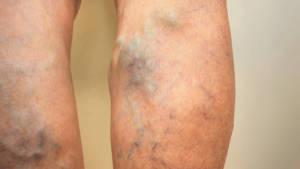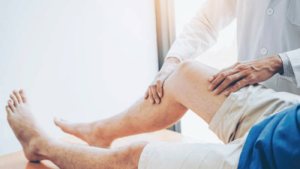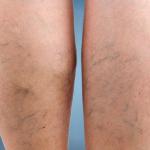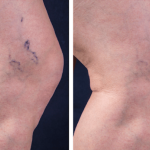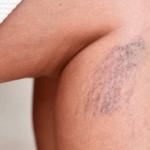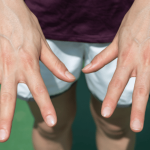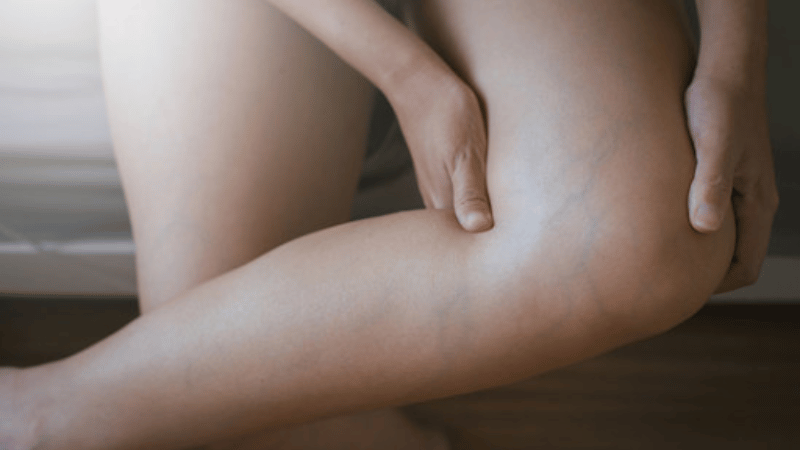
If you see greenish veins on your legs, feet, hands, or other parts of your body, you might wonder — if blood is red, why do my veins appear green? And, more importantly, are green veins a cause for concern?
The green color isn’t a problem on its own. In fact, for some people with a light to medium skin tone, green might be their normal vein color.
However, if the green color persists for veins in the legs, ankles, and feet and is accompanied by symptoms of vein damage, such as swelling, leg heaviness, or pain, it’s recommended to consult a vein specialist. Ongoing vein issues might be signs of chronic venous insufficiency or vein disease.
In this article, we explain the cause of green veins and what you can do to keep your veins healthy.
Take Our Vein Disease Symptoms Quiz
The Color of Blood Circulating Through Veins
Veins are a type of blood vessel that, like arteries and capillaries, circulate blood throughout the body.
While arteries carry oxygen-rich blood to organs and tissues, veins carry deoxygenated blood to the lungs to pick up oxygen. From there, it’s transported to the heart, which recirculates that blood to the rest of the body.
The oxygen-depleted blood in your veins is still red, even if you see green veins underneath your skin.
Human blood can be one of two colors:
- Oxygenated blood, which flows through the arteries, is bright red.
- Deoxygenated blood, which flows through the veins, is a darker red.
So what makes some veins appear green if blood is always red?
What Causes Green Veins
Veins appear green because of how light passing through the skin hits superficial veins (veins close to the skin’s surface).
Here’s how light causes green veins:
- White light consists of the entire color spectrum, from red light, which has the longest wavelength, to purple and violet light, which have the shortest.
- When light hits something, some wavelengths are absorbed and some bounce back. The colors that bounce back and hit our eyes are the ones our brain processes, so those are the visible colors.
- Red light’s longer wavelength allows it to penetrate more easily through the skin and other human tissue. As a result, we don’t see the red color when looking through the skin.
- Colors with a shorter wavelength, like green and blue, are reflected. That’s why veins can appear green, not red, even though the blood flowing through them is red.
Sign Up for Our Newsletter and Learn More About Vein Health
Factors That Make Green Veins More Visible
Green veins can become more visible for several reasons. While some reasons aren’t a cause for concern, other factors are related to your health, so it’s important to pay attention to the appearance of your veins.
Aging
As we get older, our skin often becomes thinner, making it easier to see the veins underneath the skin.
Hormonal Fluctuations
The appearance of visible veins can be caused by hormonal changes or hormonal imbalances, such as those caused by oral contraceptives, pregnancy, or thyroid disorders.
Changes in hormone levels can cause small blood vessels to dilate, making them more visible beneath the skin, especially on the legs, ankles, and feet. They can also lead to weaker vein valves and walls, contributing to the development of varicose veins.
Genetics
Like other medical conditions, people with visible veins in their family are more likely to develop the condition in their lifetime.
Weight
Veins are directly affected by a person’s weight — extra weight increases blood pressure, which can strain vein walls and make veins more visible.
Vigorous Exercise
Exercise makes our veins more visible, and vigorous exercise brings them out even more. Veins usually appear less prominent after resting and drinking water.
Although some vigorous exercise makes your veins more visible, it is still important to exercise. If you have varicose veins, many low-impact exercises can provide vein-healthy benefits such as improved circulation, healthy weight, and strong leg muscles.
Hot Weather and Sun Exposure
Veins dilate under heat, increasing blood flow and making them more prominent. Sun exposure and sunburns can also make veins more visible by damaging the collagen and other connective tissue in blood vessel walls.
Smoking or Drinking
Both smoking and drinking alcohol can cause veins to dilate temporarily, which, in turn, increases vein visibility.
Prolonged Sitting or Standing
It is more common for people who sit or stand for extended periods to develop visible veins. A sedentary lifestyle can potentially increase blood pressure, slow blood flow, and increase inflammation and fluid retention in the lower extremities, all of which can impact vein health.
Gender
Varicose veins affect more women than men, possibly because female hormones loosen the walls of veins and make valves more vulnerable to leakage. Women may also experience worsening symptoms during menstruation and pregnancy due to hormonal fluctuations and increased blood volume, which put additional pressure on the veins. The physical changes and weight gain during pregnancy can also exacerbate vein visibility and discomfort.
When to Seek Medical Care for Green Veins on the Legs
Visible green veins on the legs might be varicose veins, which are bulging, twisted veins caused by chronic venous insufficiency or vein disease.
Venous insufficiency can increase one’s risk for serious complications, including deep vein thrombosis (DVT) and skin damage, including venous ulcers. Varicose veins are common, affecting about 23% of US adults.¹
If you have green veins, particularly on your legs, and are concerned that they’re becoming more visible, schedule a consultation with a vein specialist at USA Vein Clinics.
Our experienced vein doctors provide vein health screenings and personalized treatment plans for varicose veins and spider veins. We also offer non-surgical vein treatments that can address visible veins and painful vein symptoms, such as calf cramps, leg heaviness, and swelling.
Schedule a consultation with USA Vein Clinics today at a location near you.
Frequently Asked Questions About Green Veins
How Does Skin Tone Impact Green Veins?
People with less skin pigment and a lighter skin tone are more likely to have visible green veins.
However, it is more difficult to see the color of veins in individuals with more pigment and darker skin. The increased pigment in the skin reduces the light that passes through, making the veins less visible.
The undertones in your skin also impact vein color. Skin undertones are the subtle hues underneath your skin’s surface. Warm undertones are slightly pink, peachy, or golden. Cool undertones are violet, pink, or light blue.
- Warm undertones: People with warm undertones will see green veins.
- Cool undertones: People with cool undertones will see blue or purple veins.
- Neutral undertones: People with neutral undertones might see greenish-blue or bluish-purple veins.
What Do Green Veins Mean?
In most cases, having green veins simply means the undertones in your skin allow more green light to reflect when light hits the skin. People with lighter skin might notice veins that look green, purple, or blue, as these colors have shorter wavelengths than red and bounce back more easily from veins just under the skin.
Are Green Veins Good or Bad?
Green veins aren’t good or bad. The way light hits veins in people with lighter skin tones makes veins close to the skin appear green.
However, people with visible veins, protruding veins on the legs, and vein symptoms, such as swelling and leg cramps, may have an underlying health condition. A vein specialist can help diagnose and treat the problem if you have green varicose veins or visible veins accompanied by other symptoms.
Click to Call and Schedule a Consultation
Sources
- Gregory Piazza, “Varicose Veins,” Circulation 130, no. 7 (2014): 582-587, https://doi.org/10.1161/CIRCULATIONAHA.113.008331.

